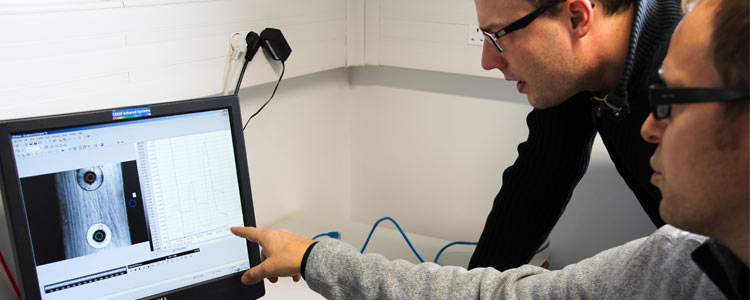Domains
Robotics, Mechatronics, Automation
Doctoral school
Doctoral School EEA Lyon, INSA Lyon, University of Lyon
Period, duration
Oct. 2023 to Sept. 2026, 3 years
Profile required
Holder of a Master 2 or an engineering degree in Robotics, Mechatronics, Mechanical Engineering with a specialization in automation or in a field related to the design, modeling and development of systems for the medical sector. Proficiency in SolidWorks or Catia (or equivalent) is required, as well as instrumentation skills. Modeling skills are desirable, and programming in MATLAB or Python will be appreciated.
Financing
2044 gross / month (+ supplement if teaching activities)
funded by the ANR HASPA project
Location
Annecy and Lyon.
This work will be carried out in 2 mechatronics laboratories. The design part will be carried out mainly at the SYMME laboratory (https://www.univ-smb.fr/symme/) located atUniversité Savoie Mont Blanc in Annecy during the first year, and the control part will be carried out mainly at the Ampère laboratory (http://www.ampere-lab.fr/) at INSA Lyon. Finally, the measurement campaign will also be carried out in Lyon on the Movement & Handicap platform at the Henry Gabrielle Hospital, which is a partner in the project.
Subject
This subject falls within the field of medical robotics, more specifically haptic simulation for learning
for learning medical gestures, and responds directly to the Haute Autorité de Santé's expectation:
"Never the first time on a patient".
Spasticity is a disorder of the central nervous system, characterized by involuntary muscle contractions.
resulting in stiffness of the limbs. This pathology affects around
15 million people worldwide. Spasticity, in association with other symptoms, can increase pain
increase pain and considerably reduce mobility in people with neurological diseases.
neurological diseases [Brown, 1994]. To assess the severity of this symptom, the degree of resistance
resistance to rapid movement is quantified using the Modified Ashworth Scale (MAS).
- Modified Ashworth Scale), the most universally used clinical tool [Bohannon, 1987].
Diagnosis is made by applying a relevant MAS score during a limb mobilization maneuver.
mobilization of the limbs. academics is currently carried out by companionship directly on injured patients.
injured patients. In addition to the ethical issues raised by this type of academics, the degree of spasticity
may change during the diagnostic evaluation session (thus modifying the patient's MAS score)
which makes it even more difficult to pass on know-how. At present, there are no
simulators for training in this procedure.
To meet this need, the ANR-funded HASPA project aims to develop a
haptic learning simulator for the lower limb, to provide an innovative tool for the
academics and training of practitioners.
Thesis objective:
The main objective of the thesis is to design and prototype a physical haptic simulator
to simulate different cases of spasticity and thus enable young practitioners to train
without risk. The aim of this PhD is to design a 3-degree-of-freedom lower limb that reproduces the ankle, the knee and the ankle joint.
freedom lower limb reproducing the ankle, knee and hip. This prototype will integrate sensors and actuators
sensors and actuators to reproduce the spastic behavior of the muscles.
Scientific challenges :
Draw up specifications in collaboration with healthcare experts.
Design and control the stiffness of a haptic interface reproducing the lower limb.
Pilot the prototype to simulate different cases of spasticity.
Generalize the methods used to design an upper limb simulator.
Original contributions expected :
Offer a high-performance haptic simulator with innovative actuation.
Integrate pedagogical exercises
Research program and proposed scientific approach :
Mechatronic design: following an analysis of practitioners' professional activities
by some of the HASPA project partners, a set of specifications is to be drawn up
be drawn up. This stage consists in defining how to technologically represent (mechanical systems
systems, actuators, sensors, etc.) the functionalities required or desired on the
simulator to enable relevant learning and to record the gestures performed.
The overall design of the physical simulator for a lower limb will have to be
be carried out. This will involve designing a host mechanical structure to integrate actuators and sensors
and sensors, and organize the manufacture of the outer shell representing a lower limb
with elastomer-type materials.
Control: for actuation, two approaches are envisaged. The first involves the use of pneumatic muscles to control the various segments of the lower limb. The advantage of pneumatic muscles lies in their low mass/power ratio and their anthropomorphic shape. They can be antagonistically driven to control joint stiffness. The second option is to design a hybrid actuator incorporating both a magneto-rheological brake (developed by one of the project partners) and a pneumatic or electric actuator, to control system compliance and benefit from the advantages of each.
Experimental validation :
Finally, the last part of the PhD will be devoted to a measurement campaign to be carried out at the Hospices Civils de Lyon (HCL) to test the prototype in situ as a learning simulator. Trials will be carried out with expert and novice practitioners to record the gestures performed by these 2 populations. Analysis of the data should enable us to define criteria linked to the learning curve of the gesture, which should differentiate these 2 populations according to criteria to be defined and which will be linked to the learning curve of the gesture.
Thesis director and co-director
Luc Maréchal, teacher-researcher, Polytech Annecy-Chambéry - SYMME
Richard Moreau, Ampère (http://www.ampere-lab.fr/) - INSA Lyon
Contact
luc.marechal
@univ-smb.fr
richard.moreau
@insa-lyon.fr
Application
The application must be sent to the supervisors by e-mail, indicating "HASPA PhD Application" in the subject line.
The application must include the following documents:
- a detailed CV,
- a letter of application explaining the candidate's motivations for embarking on a thesis, addressing the proposed subject and showing the links between the candidate's profile and the themes of the thesis topic,
- academic transcripts (Bachelor's degree, Master's degree 1 and first semester of Master's degree 2 or engineering school)
- letters of recommendation or, failing that, the names of people in the field of academic research who recommend the candidate.
